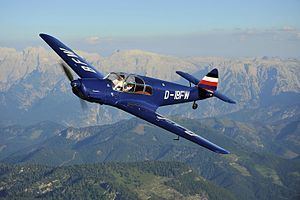Top speed 305 km/h Length 8.3 m Engine type Hirth HM 508 First flight 1934 | Wingspan 10 m Introduced 1935 Manufacturer Messerschmitt | |
 | ||
Construction of messerschmitt bf 108 aircraft augsburg germany 73572
The Messerschmitt Bf 108 Taifun was a German single-engine sport and touring aircraft developed by Bayerische Flugzeugwerke (Bavarian Aircraft Works) in the 1930s. The Bf 108 was of all-metal construction.
Contents
- Construction of messerschmitt bf 108 aircraft augsburg germany 73572
- Landing at dijon airfield with a very old messerschmitt bf 108 taifun
- Design and development
- Operational history
- Variants
- Operators
- Specifications Bf 108B
- Popular culture
- References

Landing at dijon airfield with a very old messerschmitt bf 108 taifun
Design and development

Originally designated the M 37, the aircraft was designed as a four-seat sports/recreation aircraft for competition in the 4th Challenge International de Tourisme (1934). The M 37 prototype flew first in spring 1934 powered by a 250 PS (247 hp, 184 kW) Hirth HM 8U inverted-V engine, which drove a three-blade propeller.

Although it was outperformed by several other aircraft in the competition, the M 37's overall performance marked it as a popular choice for record flights. Particular among these traits was its extremely low fuel consumption rate, good handling, and superb takeoff and landing characteristics.

The Bf 108A first flew in 1934, followed by the Bf 108B in 1935. The Bf 108B used the Argus As 10 air-cooled inverted V8 engine. The nickname Taifun (German for "typhoon") was given to her own aircraft by Elly Beinhorn, a well-known German pilot, and was generally adopted.
Operational history

Soon after the first production aircraft began to roll off the assembly line in Augsburg, several Bf 108s had set endurance records.

The Bf 108 was adopted into Luftwaffe service during World War II, where it was primarily used as a personnel transport and liaison aircraft. The aircraft involved in the Mechelen Incident was a Bf 108.
Production of the Bf 108 was transferred to occupied France during World War II and production continued after the war as the Nord 1000 Pingouin.
Variants
Operators
Specifications (Bf 108B)
Data from Jane's AWA 1938
General characteristics
Performance
Popular culture
Bf 108s and postwar Nord 1000s played the role of Messerschmitt Bf 109 fighters in war movies, including The Longest Day, The Great Escape, 633 Squadron, Mosquito Squadron, and Von Ryan's Express.
